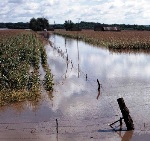
Crustacean Nanoparticles and Agricultural Runoff
When Flavio Campagnaro bought brewing equipment from an auction at a closing Molson factory in Edmonton, Alberta, Canada, it wasn’t with the intention of brewing up batches of homemade beer. Instead he’s using the drums too cook up something far more potent: pesticides.
Campagnaro is the vice president of manufacturing for ViveNano, a biotech startup that’s hoping its technology can help diminish residual chemicals in agricultural runoff. Traditional pesticides, including those used on organic crops, require what ViveNano’s CEO Keith Thomas calls a “soup of chemicals” to become water-soluble streams capable of killing weeds and other pests.
And you likely know the rest of the story – it rains, and these chemicals drain from the fields into groundwater, rivers, lakes, and streams, where they wreak havoc on the ecosystem, drinking water, and oceans.
The technology that aims to end this story uses nanoparticles to create a water-soluble “cage” that can be filled with a pesticide’s active ingredient. The two particles bond, and when the nanoparticles dissolve in water, so do the pesticide molecules. Thomas said the company sticks to such biodegradable components as chitosan, an amino acid found in crustacean shells, which makes the process more water-quality friendly.
Because nanotechnology is a relatively recent development, some are concerned that scientists have no way of knowing how its use on crops will affect humans years down the road. Thomas however, dismissed those fears. “Anytime you have a new technology, it’s impossible to know its effects,” he said. He also pointed out that, though the biosolid cage is a nanoparticle, the entire molecule is about the same size as the pesticide molecules currently fending off bugs and weeds.
The technology won’t be on the market for at least two years or so, Thomas said. It is undergoing final field testing, and then the company must spend an additional year or two working with various regulatory agencies before it receives approval to market it.
In the meantime, the company is looking at other applications, including increasing solar panel efficiency. Campagnaro said a product to diminish the energy loss that occurs when sun shines through glass-tiled solar panels should be on the market by the fall.
The technology could also be used in pharmaceutical development, though Thomas said that the financial and time investments necessary for that market are, at present, beyond the scope of the company’s resources. “We’re not that big right now, so we’re going to have to pick and choose our applications,” he said.
Posted by Laura Williams on Mar 15, 2011